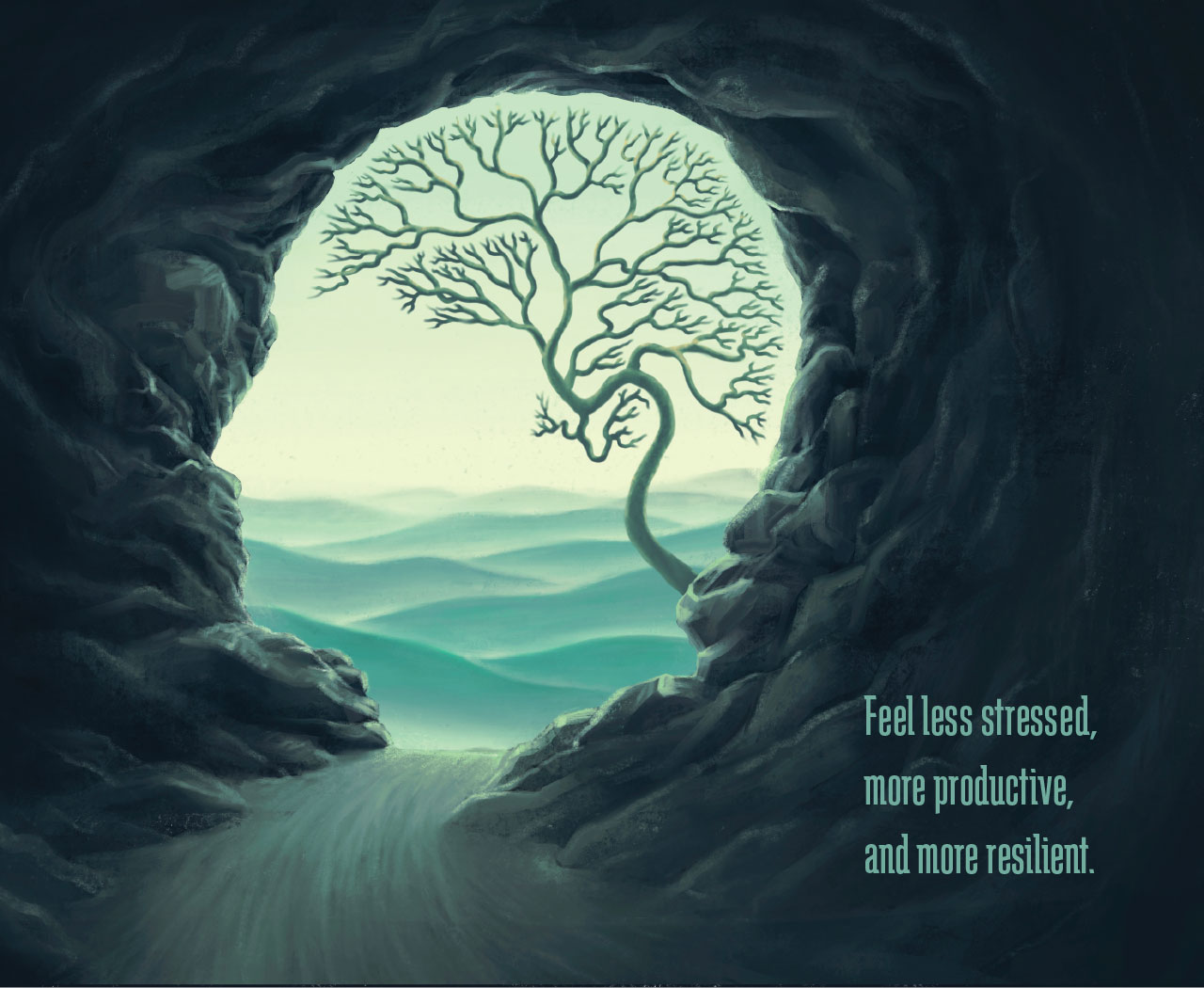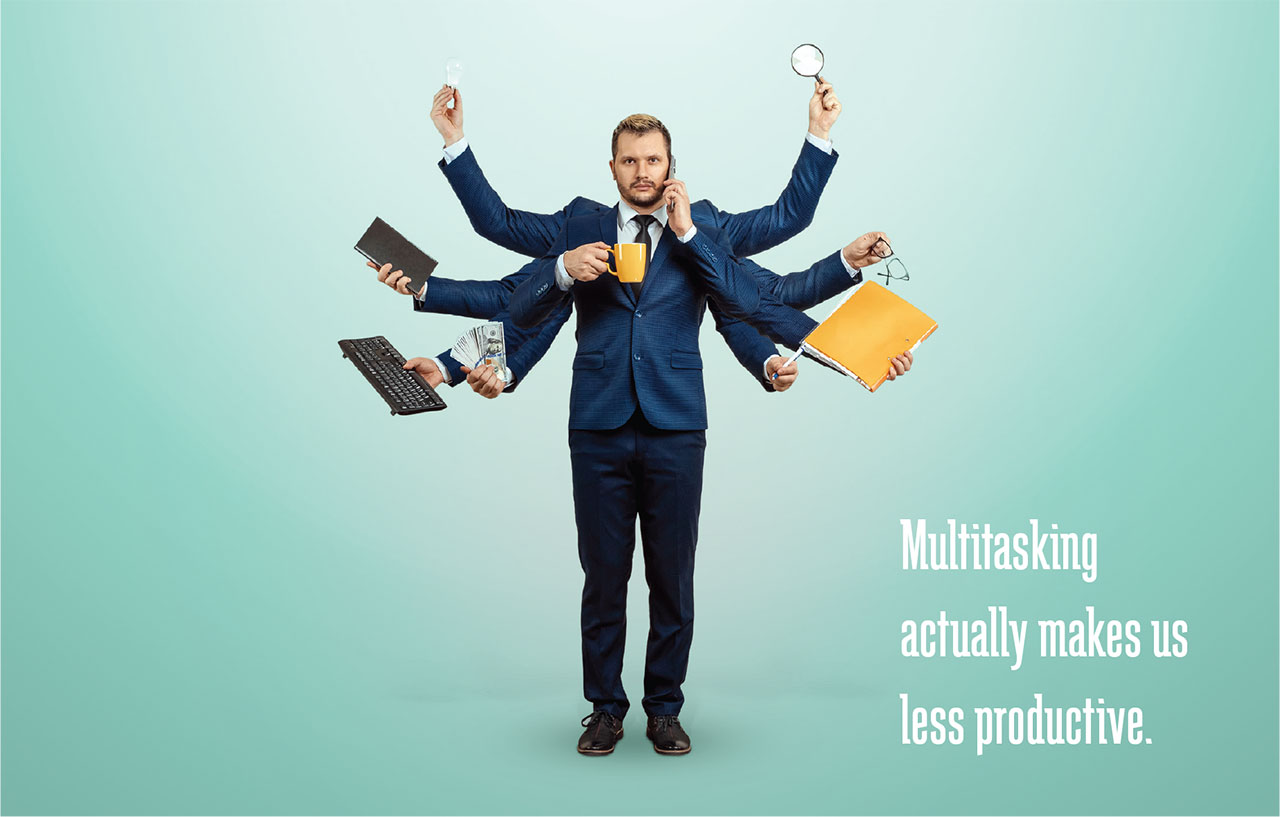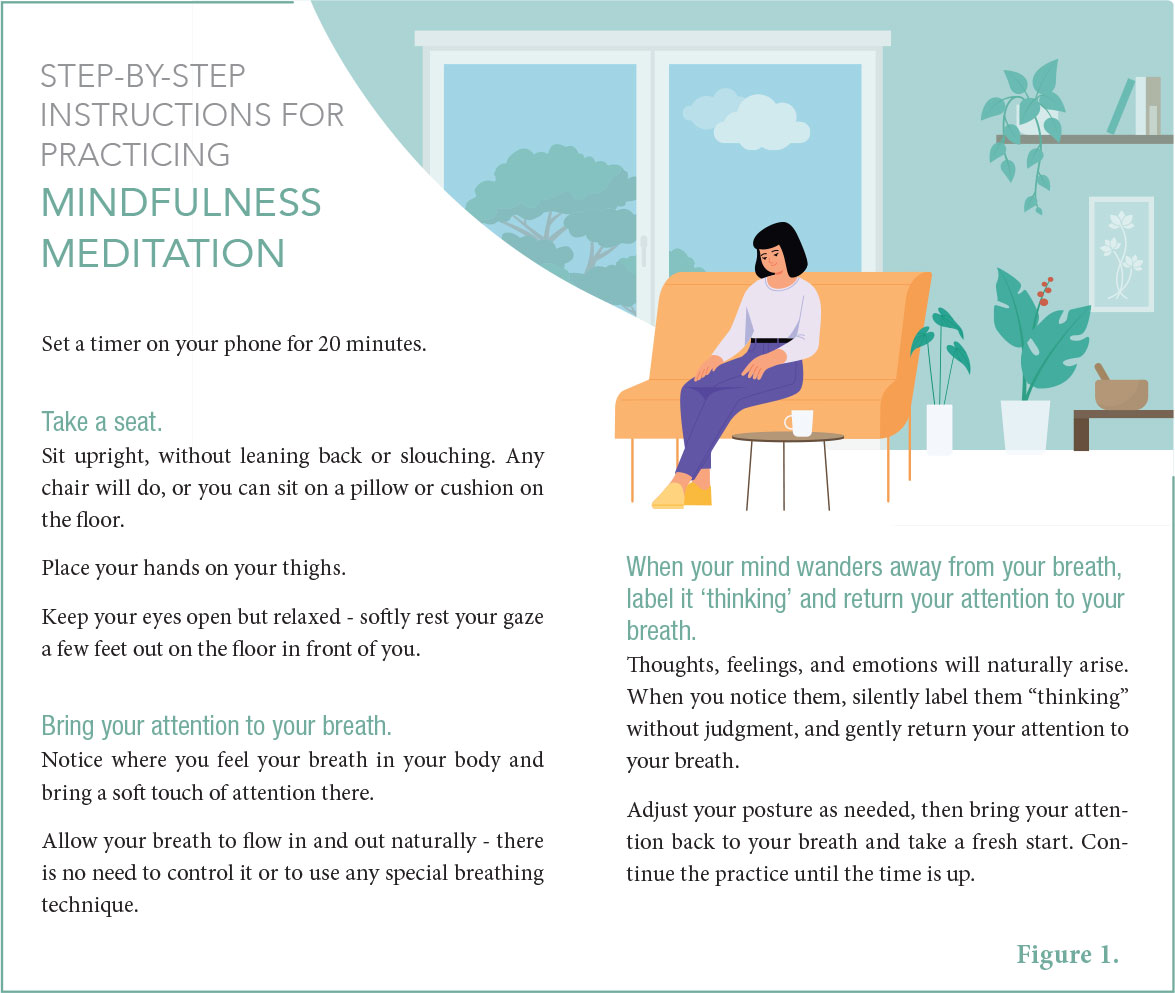
An Introduction to Mindfulness for Audiologists
Carolyn Smaka, Au.D.
Mindfulness refers to purposely giving your full attention to what’s happening now. When you make mindfulness a habit, you feel less stressed, more productive, and more resilient. It is a practical tool for audiologists to help reduce occupational stress and prevent burnout. It can improve audiologists’ personal lives as well.
Mindfulness does not require you to change who you are, to work less, or to work slower. It’s about building a habit where you can focus your attention where you want, when you want. As a result, you are less vulnerable to distractions and feel more at ease.
The way to build a habit of mindfulness is by practicing mindfulness meditation. This simple, evidence-based practice requires less time each day than a quick coffee run, with results that last much longer than a caffeine buzz. It requires no money or special equipment and is self-directed. You practice on your terms and on your schedule.
I started practicing mindfulness meditation at the start of the pandemic. Almost immediately, I noticed benefits in day-to-day situations. It helped me to manage COVID-related anxiety without overreacting, which can exacerbate stress. I got better at letting things go. This noticeably improved relationships with my immediate family—relationships that had been strained by disrupted routines and too much together time. When I’d wake up in the middle of the night, practicing mindfulness helped me fall back asleep rather than stay up ruminating on worries.
I went on to complete a 100-hour mindfulness meditation teacher training program through Dharma Moon and Tibet House, and I maintain a regular practice.
The Myth of Multitasking
Can audiologists afford to be mindful in our busy, nonstop, 24/7, hyperconnected world?
Emanuel (2021) found time to be the most common theme causing workplace stress for audiologists. Whether it is an unreasonable workload, excessive paperwork/documentation, or other job demands such as supervising staff or students, audiologists in all work settings today are pulled in many different directions.
We may multitask as an intentional strategy for time management. Mindfulness, however, may be a better solution for managing time demands.
In the book, Finding the Space to Lead, Marturano (2015) refers to an “epidemic of continuous partial attention” to describe the state of constant multitasking that is the default mode for so many people today. She states, “We go on autopilot for much if not all of our lives. We begin to believe that this is just how it has to be in the fast-paced, distraction-filled world we work and live in. If we don’t live on this incessant treadmill, we’ll fall behind, or fail.”

The Myth of Multitasking
Can audiologists afford to be mindful in our busy, nonstop, 24/7, hyperconnected world?
Emanuel (2021) found time to be the most common theme causing workplace stress for audiologists. Whether it is an unreasonable workload, excessive paperwork/documentation, or other job demands such as supervising staff or students, audiologists in all work settings today are pulled in many different directions.
We may multitask as an intentional strategy for time management. Mindfulness, however, may be a better solution for managing time demands.
In the book, Finding the Space to Lead, Marturano (2015) refers to an “epidemic of continuous partial attention” to describe the state of constant multitasking that is the default mode for so many people today. She states, “We go on autopilot for much if not all of our lives. We begin to believe that this is just how it has to be in the fast-paced, distraction-filled world we work and live in. If we don’t live on this incessant treadmill, we’ll fall behind, or fail.”

Yet, multitasking actually makes us less productive—and generally more stressed, at the end of the day.
Why? When we multitask, we rarely do two things at once; instead, we rapidly switch between tasks. Each time we switch tasks, we lose time, and it adds up. For most tasks, this makes us less efficient and results in lower-quality output.
Studies show that heavy media multitaskers (i.e., those who use more than one device at a time, such as working on a laptop and texting on a phone) have differences in cognition compared to light media multitaskers. Heavy media multitaskers have poorer short-term memory, poorer long-term memory, more forgetfulness, and more trouble with tasks that require sustained attention (Uncapher & Wagner, 2017).
While multitasking is sometimes necessary, there are definite tradeoffs. Consider adding mindfulness as a strategy for working smarter and feeling better on hectic days.
Benefits, Evidence, and Applications
The many benefits of mindfulness meditation can be summarized into three: strength, stability, and clarity in everyday life.
People who practice mindfulness meditation report they are better able to manage stress, feel more resilient, and are less reactive in stressful situations. They report more clarity, which allows them to see situations as they are, without added drama.
There is extensive research showing these and other benefits of mindfulness meditation. A PubMed search for “mindfulness meditation” yields more than 3,100 results, including more than 200 randomized controlled trials and more than 100 systematic reviews.
Neuroimaging studies like those that use fMRI are starting to uncover the neural signature of mindfulness meditation. Among the findings: People who meditate (i.e., all types of meditation, including mindfulness meditation) have changes in the structure and function of their brains in the areas responsible for self-awareness and self-regulation. See Boccia, Piccardi, & Guariglia (2015) for a review of this fascinating research.
Corporate/Business Applications
Forbes estimates that half of Fortune 500 companies have implemented mindfulness programs (Lau, 2020). Companies such as Google, Fidelity, Goldman Sachs, AstraZeneca, Nike, General Mills, and the Hospital for Special Surgery report measurable employee benefits from these programs, including increased job satisfaction, improved productivity, and reduced stress/burnout. Intel reports more creativity, innovation, and higher productivity as a result of its mindfulness program, Awake@Intel (Intel, 2015).
These benefits directly impact companies’ bottom lines. After implementing a year-long mindfulness-based wellness program, Aetna saw a 7% reduction in medical claims which translated to $9 million in savings (Gelles, 2015).
Healthcare Applications
Mindfulness meditation is used to complement treatments for a long list of health conditions. The National Center for Complementary and Integrative Health (NCCIH), part of the National Institutes of Health, provides an excellent summary of selected research on mindfulness to treat stress, anxiety, depression, high blood pressure, pain, insomnia/sleep, substance use disorder, post-traumatic stress disorder, cancer, weight control/eating behavior, and attention-deficit hyperactivity disorder (NCCIH, 2022). Much of the research is positive, showing beneficial results, although some of it is preliminary and lacks rigor.
NIH-funded research on mindfulness continues, with studies underway examining its utility in the treatment of migraine, opioid use disorder, stress in first responders, and more.
Perhaps the most well-known application of mindfulness meditation is Mindfulness-based Stress Reduction (MBSR), which was developed in the 1970s by Jon Kabat-Zinn. MBSR is a structured multi-week program for managing stress, anxiety, pain, and depression with mindfulness meditation at its core. MBSR principles are used for tinnitus management in a program designed by psychologist Jennifer Gans (see mindfultinnitusrelief.com).
Health Professionals
There are many studies indicating that mindfulness improves not only health professionals’ well-being but also the care they provide to their patients (e.g., Calabrese, 2019; Watson, Walker, Cann, & Varghese, 2022; Chmielewski, Łoś, & Łuczyński, 2022).
In a 2019 article in the Journal of Patient Experience, Dr. Leonard Calabrese of the Cleveland Clinic calls mindfulness and meditation a “no-brainer” for healthcare professionals. The Cleveland Clinic Lerner College of Medicine includes meditation and mindfulness as part of a mandatory curriculum for medical students because of the proven benefits for both physicians and patients.
Audiology and Mindfulness
It has been suggested that mindfulness can help audiologists reduce burnout (Kasper, 2009; Sinnott & Mukherjee, 2020) and can make audiologic counseling more effective (Taie, 2019). In addition to helping audiology clinicians to manage stress, improve productivity, and enhance resilience, mindfulness has advantages for audiology practice owners.
Mindful leaders are present, focused, compassionate, selfaware, and inspiring. They empower and engage others and are effective at shepherding change—important skills for audiology leaders in these rapidly changing times.
Whereas a transactional leader is focused on managing tasks using rewards and punishments, a mindful leader is focused on empowering others. More aligned with the skills needed for managing high-achieving audiologists, mindful leadership is a transformative leadership style. It is focused on creating opportunities to develop people and teams.
Mindfulness Meditation is the Key
How do we become mindful audiologists and mindful leaders? By practicing mindfulness meditation. Mindfulness meditation makes mindfulness automatic in everyday life.
Pay Attention to Your Breath - No Mountain Climbing Required
If the idea of mindfulness meditation conjures up an image of a person sitting cross-legged on the top of a mountain with their eyes closed, it is because that is the most typical depiction of the practice in mainstream media. The reality of this simple, everyday practice is more mundane.
Mindfulness meditation is typically done while seated. Any chair will do; it is not necessary to sit on the floor or on a cushion unless you prefer it. Mindfulness meditation is done with the eyes open, for more carryover into real life.
You start by paying attention to your breath. Thoughts, feelings, and emotions come up. You notice them, then you bring your attention back to your breath. This is done again and again for the duration of the practice. It is a process of noticing thoughts and refocusing attention; redirection is the practice.
A common misconception is that meditation involves slowing the mind or controlling thoughts; that is not true for mindfulness meditation. The point is to notice thoughts; once we become familiar with the constant pinging of our thoughts, they do not have as strong a pull on our attention. We can see thoughts come and go without getting caught up in them.
Getting Started
Mindfulness meditation is completely self-directed, so you do it in your space, on your time. No app is required. You do not need any special equipment. You do not need a teacher or a subscription, and there is no cost involved. Mindfulness meditation supports all belief systems. It is a secular practice that has been adapted from its original Buddhist roots; its benefits are available to anyone willing to practice. To get started, set aside time each day for one week and give it a try. Step-by-step instructions are provided in Figure 1.


Don’t Just Do Something - Sit There
Although mindfulness meditation is simple, it is not easy. Making the time to sit and “do nothing” seems counter to our goal-driven, overachieving culture. There is nothing sexy or “Instagrammable” about sitting and noticing your thoughts, but the benefits are well worth it.
As with any new behavior or habit you want to develop, mindfulness meditation requires practice. To get results, it is recommended to practice for a minimum of 20 minutes per day, four to five days per week.
Finding a consistent time to practice can help to build a routine. I find that keeping a log on my phone with dates/lengths when I practice helps me to stay on track. Finding a friend who is interested in starting to practice meditation can also be helpful. You can practice together in person or via FaceTime, share your experiences, and keep one another motivated.
Summary
Mindfulness meditation is a powerful, evidence-based tool for managing stress and building resilience. Being mindful does not mean being someone better or different or slowing down. It is about developing a habit of being more intentional with your time and attention. It is practical and cost-effective. With proven benefits for both individuals and organizations, mindfulness can be a game changer for audiology clinicians, practices, and business owners. ■
References
- Boccia, M., Piccardi, L., & Guariglia, P. (2015). The meditative mind: A comprehensive meta-analysis of MRI studies. BioMed research international, 419808. 10.1155/2015/419808
- Calabrese, L.H. (2019). Why mindfulness/meditation is a “no-brainer” for health-care professionals. Journal of Patient Experience, 6(1), 21-23. 10.1177/2374373518774390
- Chmielewski, J., Łoś, K., Łuczyński, W. (2021). Mindfulness in healthcare professionals and medical education. International Journal of Occupational Medicine and Environmental Health, 34(1), 1-14. 10.13075/ijomeh.1896.01542
- Emanuel, D.C. (2021a). Occupational stress in U.S. audiologists. American Journal of Audiology, 30(4), 1010-1022. 10.1044/2021_AJA-20-00211
- Gelles, D. (2015, February 27). At Aetna, a C.E.O.’s management by mantra. NYTimes.com.
- Intel. (2015, May 4). Slowing down to speed up. Intel.com.
- Kasper, C.A. (2009). Zen audiology: Cultivating mindfulness and the potential impact on your practice, profession, and personal life. Audiology Today, 21(3), 52–55.
- Lau, Y. (2020, October 5). Increasing mindfulness in the workplace. Forbes.com.
- Marturano, J. (2015). Finding the space to lead: A practical guide to mindful leadership. Bloomsbury Press.
- National Center for Complementary and Integrative Health (NCCIH). (2022). Meditation and mindfulness: What you need to know. NCCIH.NIH.gov.
- Sinnott, L., & Mukherjee, R. (2020). Mindfulness. Canadian Audiologist, 9(1).
- Teie, P.U. (2019, April 16). Mindful counseling. Hearinghealthmatters. org.
- Uncapher, M.R., & Wagner, A.D. (2017). Minds and brains of media multitaskers: Current findings and future directions. PNAS, 115(4), 9889-9896. 10.1073/pnas.1611612115
- Watson, T., Walker, O., Cann, R., & Varghese, A. K. (2022). The benefits of mindfulness in mental healthcare professionals. F1000Research, 10, 1085. 10.12688/f1000research.73729.2
Carolyn Smaka, Au.D., is Editor in Chief at Continued.com, an online continuing education company whose professional learning spaces include AudiologyOnline and SpeechPathology. com. Carolyn is also a certified mindfulness meditation teacher and is always happy to share meditation tips and resources. She can be reached at:
